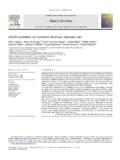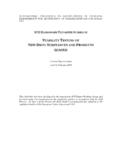Transcription of FIRST DRAFT Guideline on clinical evaluation of …
1 30 Churchill Place Canary Wharf London E14 5EU United Kingdom An agency of the European Union Telephone +44 (0)20 36606000 Facsimile +44 (0)20 3660 5555 Send a question via our website European Medicines Agency, 2018. Reproduction is authorised provided the source is acknowledged. 26 April 2018 1 EMEA/CHMP/VWP/164653/05 Rev. 1 2 Committee on Human Medicinal Products (CHMP) 3 4 Guideline on clinical evaluation of vaccines 5 6 DRAFT 7 8 9 DRAFT Rev. 1 agreed by Vaccine Working Party (VWP) March 2017 Adopted by CHMP for release for consultation 26 April 2018 Start of public consultation 30 April 2018 End of consultation (deadline for comments) 30 October 2018 10 This Guideline replaces Guideline on the clinical evaluation of new vaccines 11 (EMEA/CHMP/VWP/164653/05) including its Annex on SPC requirements 12 (EMEA/CHMP/VWP/382702/06) and Guideline on adjuvants in vaccines for human use 13 (EMEA/CHMP/VEG/134716/04) 14 15 16 Comments should be provided using this template.
2 The completed comments form should be sent to 17 Keywords Vaccine, humoral immune response, cellular immune response, vaccination schedule, immunogenicity studies, protective efficacy, effectiveness, safety, immune correlates of protection 18 Guideline on clinical evaluation of vaccines EMEA/CHMP/VWP/164653/05 Rev. 1 Page 2/21 Guideline on clinical evaluation of vaccines 19 20 Table of contents 21 Executive summary .. 3 22 1. Introduction (background) .. 4 23 2. 4 24 3. Legal basis and relevant guidelines .. 5 25 4. Immunogenicity .. 6 26 Characterisation of the immune response .. 6 27 Immune correlates of protection .. 6 28 Design of comparative immunogenicity trials .. 7 29 Primary and secondary endpoints .. 7 30 Primary analyses.
3 8 31 Formulation, dose and schedule .. 9 32 Formulation and dose .. 9 33 Schedule .. 9 34 Route and/or method of administration .. 11 35 Concomitant administration .. 11 36 Lot-to-lot consistency .. 11 37 5. Efficacy .. 12 38 Requirements for efficacy trials .. 12 39 Efficacy trial designs .. 13 40 Case 14 41 Case ascertainment .. 14 42 Duration of follow-up for efficacy .. 15 43 Analyses of efficacy .. 15 44 Primary endpoint .. 15 45 Primary analysis .. 15 46 Other issues for the interpretation of vaccine efficacy .. 16 47 Other approaches for estimating vaccine efficacy .. 17 48 6. Effectiveness .. 17 49 7. Safety .. 18 50 Assessment of safety in clinical trials .. 18 51 Size of the safety database .. 19 52 8.
4 Special populations .. 20 53 Pregnant women .. 20 54 Elderly subjects .. 20 55 Immunodeficient subjects .. 21 56 57 58 Guideline on clinical evaluation of vaccines EMEA/CHMP/VWP/164653/05 Rev. 1 Page 3/21 Executive summary 59 This Guideline addresses the clinical evaluation of vaccines intended for the prevention of infectious 60 diseases. It includes considerations for trials intended to document the safety, immunogenicity and 61 efficacy of new candidate vaccines and to support changes in the prescribing information of licensed 62 vaccines. It also considers the need for and use of vaccine effectiveness studies. 63 Since the adoption of EMEA/CHMP/VWP/164653/2005 many new vaccines have been approved in the 64 EU or have received a positive opinion under Article 58 of Regulation (EC) No 726/2004, including 65 several intended to prevent infectious diseases for which there was previously no vaccine available.
5 66 Some of these vaccines include antigenic substances from multiple pathogens or from multiple 67 subtypes of a single pathogen. These applications have raised several issues for vaccine clinical 68 development programmes that were not addressed in the previous Guideline . Furthermore, there have 69 been requests for scientific advice on vaccine clinical development programmes that have pointed to 70 the need to provide updated or additional guidance on some issues. For example, on considerations for 71 conducting vaccine efficacy trials, identification of immune correlates of protection, vaccines intended 72 to be used in heterologous prime-boost regimens and vaccines to be administered to pregnant women 73 to protect their infants during the FIRST months of life.
6 74 In response to recurring issues arising in scientific advice and in application dossiers, this revised 75 guidance includes a discussion of factors to consider when planning and interpreting the results of 76 comparative immunogenicity trials. For example, the importance of considering the severity, mortality 77 and/or risk of permanent sequelae of the infectious disease to be prevented as well as the robustness 78 of the assays to determine the immune response when selecting non-inferiority margins and assessing 79 the clinical impact of failing to meet pre-defined criteria. In trials that compare candidate and licensed 80 vaccines containing antigens from different numbers of subtypes of the same organism consideration is 81 given to interpretation of immune responses to non-shared subtypes.
7 82 The Guideline also expands on considerations for the design of vaccine efficacy trials, including the 83 selection of appropriate control groups in different circumstances. Moreover, the role of sponsors in the 84 provision of vaccine effectiveness data in the post-licensure period has been reconsidered to reflect the 85 fact that most studies are conducted by public health authorities. 86 There are some special considerations for the evaluation of vaccine safety in clinical trials, including 87 the parameters to be documented in specific age sub-groups. The Guideline addresses general 88 considerations for the size of the pre-licensure safety database, such as the vaccine construct and the 89 use of antigens or adjuvants not previously included in licensed vaccines.
8 90 91 Guideline on clinical evaluation of vaccines EMEA/CHMP/VWP/164653/05 Rev. 1 Page 4/21 1. Introduction (background) 92 The Guideline on clinical evaluation of vaccines (EMEA/CHMP/VWP/164653/2005) covered the clinical 93 development of vaccines intended to provide pre- and post-exposure prophylaxis against infectious 94 diseases. The Guideline on adjuvants in vaccines for human use (EMEA/CHMP/VEG/134716/2004) 95 included a section on the clinical evaluation of vaccines proposed to contain adjuvants. This revision 96 combines the clinical guidance provided in these two documents. In replacing them, it updates and 97 adds to the guidance provided previously to address issues that have come to light since they came 98 into operation. 99 2. Scope 100 This Guideline is focussed on the clinical development of vaccines intended for the prevention of 101 infectious diseases, whether administered before infection occurs or for post-exposure prophylaxis.
9 It 102 does not address the clinical development of immuno-therapeutic products. 103 The guidance is relevant to vaccines intended to prevent infectious diseases due to single pathogens, 104 including those directed at multiple subtypes of single pathogens, and to vaccines consisting of 105 multiple antigenic components intended to prevent a range of infectious diseases. It is relevant to 106 vaccines that contain: 107 Organisms that have been inactivated by chemical or physical means; 108 Live organisms that are naturally non-virulent in humans or that have been treated or 109 genetically modified to attenuate their virulence; 110 Antigenic substances extracted from pathogens or secreted by them, which may be used in 111 their native state, detoxified by chemical or physical treatments or aggregated, polymerised or 112 conjugated to a carrier to increase their immunogenicity; 113 Antigenic substances produced by genetic engineering or chemical synthesis; 114 Live bacterial or viral vector vaccines expressing foreign antigenic substances.
10 115 Naked nucleic acid, including plasmids engineered to express specific antigens. 116 The Guideline addresses clinical development programmes to support the approval of candidate ( 117 unlicensed) vaccines, adjuvanted or non-adjuvanted, and to support modifications to vaccines in the 118 post-approval period ( changes in, or additions to, the posology, the age range for use or 119 recommendations for concomitant vaccination). 120 The guidance addresses trials to document vaccine safety, immunogenicity and/or efficacy. It considers 121 situations in which a pre-licensure demonstration of vaccine efficacy would or would not be required, 122 the design of pre-licensure trials to evaluate vaccine efficacy and the assessment of vaccine 123 effectiveness in the post-approval period.














